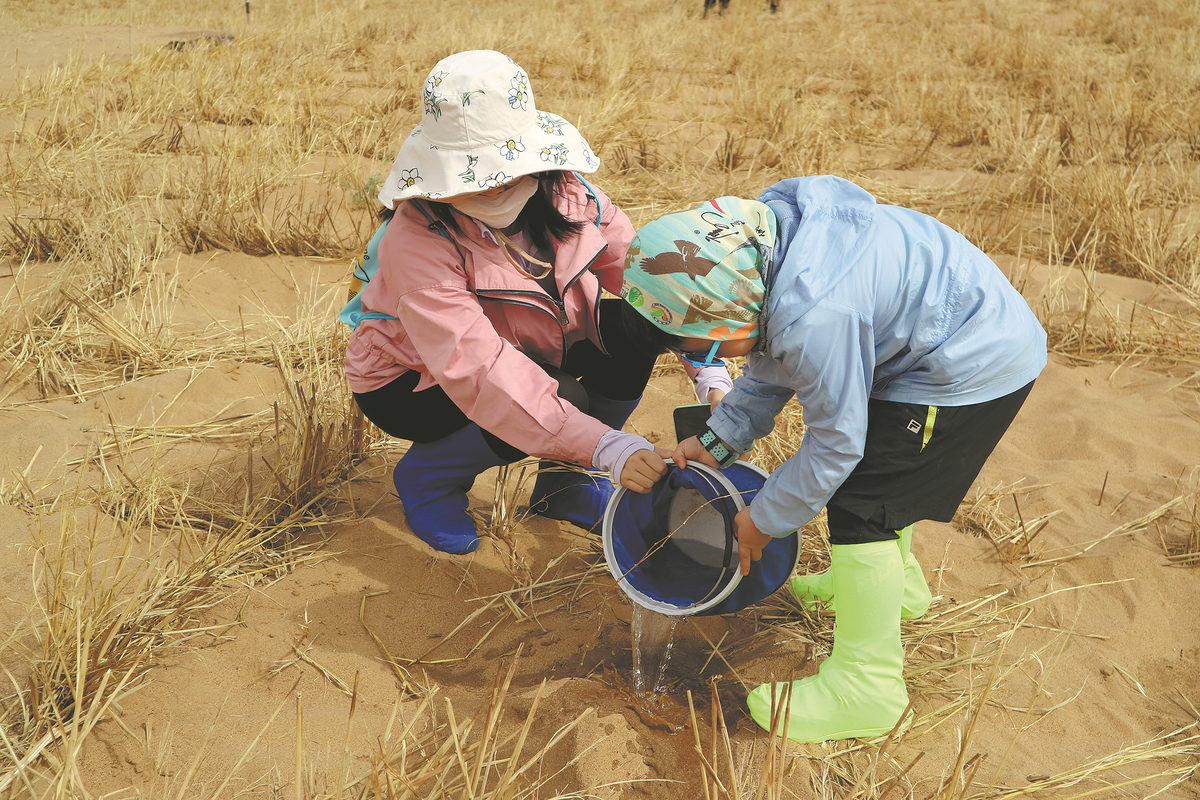Tree project instills eco-consciousness in children


In a field where the sand has been fixed with grass squares in advance, 5-year-old Shi Jiangyu wields a shovel to dig two holes with a depth of 50 centimeters — a difficult task for him, but one he manages on his own.
Carefully, he places two saplings of a drought-resistant plant species in each hole, fills the holes with sand and tamps them down with his feet.
After pouring one bucket of water into the sand-filled holes, the exhausted boy finally seeks assistance from his mother, who helps him carry two other buckets.
"It is so hard to plant trees in the desert," Jiangyu said, reflecting on his experience in the arid climate after the initial excitement of his first encounter with it. "Digging holes, using a lot of water, and the plants might still die."
The little boy is one of the 27 children age 3 to 14 who recently took part in a tree planting activity in Alshaa Left Banner of Alshaa League, Inner Mongolia autonomous region. The activity organized by the Society of Entrepreneurs & Ecology Conservation, a Chinese NGO, served as a way to make them more charitable and environmentally conscious through a hands-on activity.
Alshaa Left Banner is in an arid region characterized by a typical continental climate with strong winds and little rainfall. About 80 percent of the banner is covered by deserts — it is home to two of the three major deserts in Inner Mongolia, the Tengger and Ulan Buh — and desertified land, according to the local forestry and grassland bureau.
With a delicate ecological balance disrupted by significant vegetation degradation and land desertification, this area plays a crucial role in ensuring ecological security in northern China. Drought-resistant species such as saxaul, Calligonum mongolicum and Hedysarum scoparium are effective in stabilizing sand within the area.
Zhang-Wu Yihan, an 11-year-old Beijinger, said proudly that she has planted six seedlings with a companion her age, surpassing their original goal of planting three.
She expressed admiration for the resilience of local farmers and noted the challenging drought conditions in the region.
"Because my mother is from Hohhot, I have been to Inner Mongolia several times. However, it's very different here, because there's not much water," Yihan said.
"I have seen some camels, most with small or even no humps. Because there's little water, there aren't many plants for the camels to eat, so they have to use the fat in their humps," she added.
Despite taking part in the tree planting activity for three consecutive years, Teng Pengju remains uncertain about the meaning of the word "charity". However, because of his efforts, the 10-year-old has learned other terms such as drip irrigation, a method used to prevent water waste.
He also now voluntarily picks up discarded plastic bottles he sees whenever he walks in the desert.
"Continued experience enables children to grasp the challenges of desert control more effectively. I believe it's crucial to sow the seeds of combating desertification within the hearts of future global citizens," said his father Teng Peng, adding that Pengju is willing to share his knowledge of nature conservation and biodiversity with his classmates.
Yang Youlin, former coordinator of the Regional Bureau for Asia and the Pacific, part of the United Nations Convention to Combat Desertification, said, "Desertified regions account for a quarter of the world's land area, affecting more than 110 countries and 1 billion people and resulting in annual economic losses of $42 billion."
These statistics are exactly why it's important that people from all walks of life get involved in the effort to curb the problem, Yang said.
"Desertification, being the most critical environmental and socioeconomic issue, should be common knowledge for citizens of all ages, including both the old and the young," he said.
Yang said that a combination of natural and man-made factors can result in land degradation and desertification, subsequently exacerbating the occurrence of more intense disasters affecting both nature and humanity. This involves reducing the land's resilience to climate fluctuations, decreasing soil fertility and cutting productivity, and even leading to conflicts over resource acquisition driven by hunger and poverty.
"The UN has set a target to achieve land degradation neutrality by 2030," Yang said, adding that China has taken the lead in desert control and has become the first country to meet the objective.
Yet there is still much progress to be made, and this issue cannot be addressed within this generation, he said.
"Schools, parents and society should work together to educate children and involve them in desert control from an early age, as they are the stewards and architects of the future," he added.
- China implements strict monkeypox protocols amid rising global cases
- Mother climbs fence at Terracotta Warriors exhibition amid child's medical emergency
- Chinese mainland Olympians to visit Macao: SAR govt
- Maritime patrol and law enforcement operation carried out in the Taiwan Strait
- Global youth discovers importance of China's intangible cultural heritage
- Chinese manned submersible completes 300th dive





































